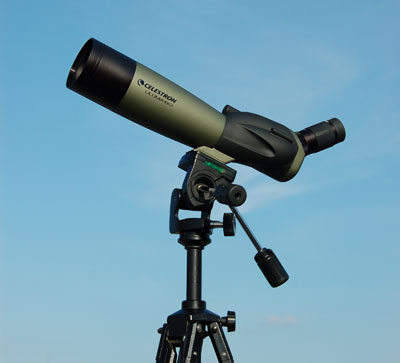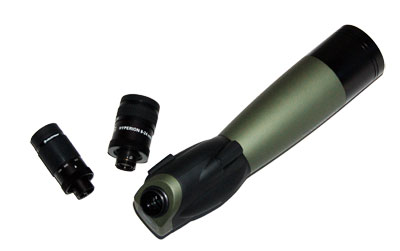Spotting scopes are an interesting alternative to binoculars with their low magnification and the expensive and bulky telescopes. They are basically simple telescopes which are designed for terrestrial observation. For this purpose, prisms are permanently built into them, so that the view is upright and true – and not mirrored and upside-down like in an astronomical telescope.
As a rule of thumb, most spotting scopes have zoom eyepieces for magnifications between 10x and 70x. On many spotting scopes you can even use other eyepieces, but for nature observation higher magnifications rarely make sense due to air turbulence. The image flickers too much when the ground is heated up by solar radiation and warm air rises. In addition, the image errors can become more obvious with increasing magnification or field of view. Most affordable spotting scopes use achromatic lenses. These show a more or less conspicuous color error, which manifests itself usually as a blue fringe at high contrast edges or around bright stars. It becomes more noticeable when the focal length is relatively short in relation to the aperture (the diameter of the front lens). A device with an 80mm aperture and 480mm focal length will show more prominent color fringes than one with an 80mm aperture and 900mm focal length. Spotting scopes with ED optics or apochromatic lenses show no noticeable color errors, but with the same aperture they cost much more than the simpler designs.

Especially practical and comfortable are spotting scopes with an angled view. You do not need a very high tripod for observing nature, and you do not have to crawl under the scope to look into the night sky. But you need a stable tripod nevertheless.
Because of the higher magnification you can clearly see if you have located a star or a planet, and many star clusters appear significantly better resolved. On the other hand, orientation in the sky is a little harder because the field of view is smaller. Many spotting scopes either have no viewfinder at all or only a sight tube. This works fine in terrestrial observations, since you can find many features for correct orientation. But for observing of the sky it is, however, more problematic – at first glance, all stars look the same in the eyepiece.
When buying a spotting scope, also have a look at the field of view and eye relief of the eyepiece. If you need glasses – the same goes for sunglasses, after all, the devices are made for observing nature – you should pay attention to an eye relief of about 20mm and adjustable eyecups. Eyepieces with a larger field of view prevent tunnel vision – then you don‘t have the feeling of looking through a narrow tube. Some eyepieces are prone to kidney beaning – they show bean-shaped black spots at the edge of the field if your eye is not exactly on the optical axis of the scope.

Many spotting scopes have interchangeable eyepieces. So you can, for example, achieve higher magnifications or use zoom eyepieces of higher quality with a larger field of view. However, the focus point of spotting scopes is less flexible than that of astronomical telescopes, and you can‘t use every eyepiece with every spotting scope, even if it adapts mechanically.
Thus, the spotting scope is a cross between the flexible telescope with its extensive accessories and binoculars that you can always carry with you, but which offer only one magnification. You must decide for yourself what you like most, and it also depends on what you want to use the instrument for.
